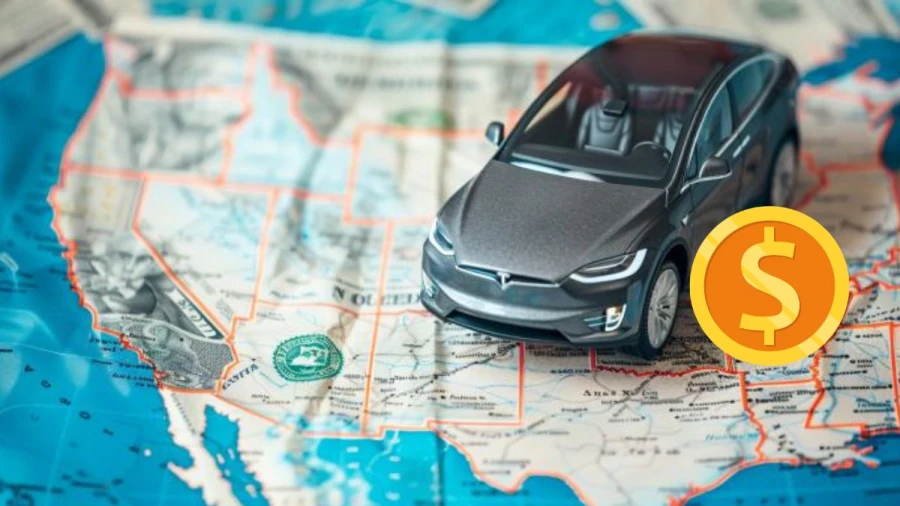
Electric Vehicles Tax Credit 2024, How Do EVs Qualify for Tax Credits?
The Electric Vehicles Tax Credit is part of a larger reform undertaken by the US Congress to enact the Inflation Reduction Act 2022 to reduce carbon emissions in the USA and incentivize EV usage across the US.
by Damodharan N
Published Apr 01, 2024 | Updated Apr 01, 2024 | 📖 7 min read
Electric Vehicles Tax Credit 2024
Electric vehicles have picked up pace since 2012 and have accelerated buyers due to a fall in battery prices, affordability, and the improved range of EVs across the world. In 2024, the electric vehicle tax credit amount will be $7,500 in the US.
This 7,500 is divided into two categories. Based on the Critical Minerals criteria, you will earn $3,750, and the Battery Components criteria will earn $3,750, for a total of $7,500. Additionally, the home location recharge facility earns $1,000.
Let's look at the eligibility criteria for many US consumers who bought EVs before the input tax credit and are now looking for ways to get that credit thanks to the Inflation Reduction Act 2022.
How Do EVs Qualify for Tax Credits?
The EVs that qualify for the input tax credit are based on the cut-off date, manufacturer’s suggested retail price (MSRP), vehicle type and use, final assembly in North America, critical minerals, battery components, and battery capacity.
Each of these signifies whether the EV that you have will be eligible for that input tax credit. This is only for vehicles alone; as far as the individual is concerned, they are categorized by their annual gross income (AGI) levels, which will be a separate criterion in itself. Now let us look at each of them one by one.
Eligibility Criteria
Persons who are eager to get an EV tax credit should probably check what annual gross income one pays to the IRS. This is one of the most straightforward ways to know before going into that highly nuanced question of whether your vehicle will be eligible or not.
For Person
The individuals who are eligible based on their annual gross income range and the date of the vehicle brought range:
If you bought the EV in 2023 and beyond with an annual gross income range for the current or previous year.
- $300,000 or less for joint IRS tax filers with a surviving spouse.
- $225,000 or less for Head of Household IRS Tax Filers.
- $150,000 or less for all the other IRS tax filers.
If you have brought an EV that was a used vehicle with an annual income gross range for the current or previous year,
- $150,000 or less for joint IRS tax filers with a surviving spouse.
- $112,500 or less for Head of Household IRS Tax Filers.
- $75,000 or less for all the other IRS tax filers.
If your annual gross income satisfies these categories, then congratulations! You have just crossed the first part of the requirements criteria to get that coveted and rightful EV tax credit. Let’s now look at the vehicle qualification criteria.
Qualification and Cut-off Date for EV Tax Credit
If your annual income qualification for a person satisfies the EV tax credit criteria, then now look at whether your electric vehicle might also be eligible for it.
For Vehicle
Electric vehicle criteria are highly classified into various subcategories like cut-off date, manufacturer’s suggested retail price (MSRP), vehicle type and use, final assembly in North America, critical minerals, battery components, and capacity of batteries.
Vehicles placed in service on or after April 18, 2023
Criteria |
Details |
|
Cut-off Date |
Vehicles placed in service on or after April 18, 2023. |
|
Manufacturer’s Suggested Retail Price (MSRP) |
$80,000 for Category-I vehicles. |
|
Vehicle Type and Use |
Category-I vehicles: vans, sport utility vehicles, and pickup trucks. Category II: all the other vehicle types. |
|
Final Assembly in North America |
Yes, it is a must. North America includes ( Mexico, Canada, Puerto Rico, and the United States) |
|
Critical Minerals |
To qualify for the $3,750 critical minerals portion of the tax credit, the battery's critical minerals must meet certain sourcing requirements: - 2023: 40% - 2024: 50% - 2025: 60% - 2026: 70% - 2027 and later: 80% |
|
Battery Components |
To qualify for the $3,750 battery component portion of the tax credit, the battery's components must meet certain manufacturing thresholds: - 2023: 50% - 2024 and 2025: 60% - 2026: 70% - 2027: 80% - 2028: 90% - 2029 and later: 100% |
|
Capacity of batteries |
The capacity of the battery in the vehicle must be at least seven kilowatt-hours (kWh). |
|
Total tax credit amount for this category |
7,500, which is split between $3,750 for battery components and another $3,750 for critical minerals. If you are looking for a home recharge facility, then an additional $1,000 might come your way based on the location. |
Note to locate the price of the manufacturer’s suggested retail price; otherwise, the “Monroney Label” can be located on the window screen and can also be asked to locate them with the help of dealer guidance.
In service after January 1, but not later than April 18th, 2023
Criteria |
Details |
|
Cut-off Date |
Vehicles sold on or after January 1 and placed in service before April 18, 2023. |
|
Manufacturer’s Suggested Retail Price (MSRP) |
Not Known |
|
Vehicle Type and Use |
Eligible vehicles include both electric vehicles (EVs) and fuel cell electric vehicles (FCEVs). for own use only |
|
Final Assembly in North America |
Must Required |
|
a manufacturing cap |
It is not eligible as it was removed on January 1, 2023. |
|
Critical Minerals |
Not Known |
|
Battery Components |
Not Known |
|
Capacity of batteries |
The vehicle's battery capacity must be at least seven kilowatt-hours (kWh). |
|
Total Tax Input Credit |
Total: 7,500, with a base amount of $2,500. Additional 417$ for 7 kWh battery capacity and 417$ for every KWh with 5 kWh extra capacity. |
Brought between August 17 and December 31, 2022
Criteria |
Details |
|
Cut-off Date |
Vehicles sold between August 17 and December 31, 2022 |
|
Manufacturer’s Suggested Retail Price (MSRP) |
Not Known |
|
Vehicle Type and Use |
Electric vehicles (EVs) for personal use only. |
|
Final Assembly in North America |
Must required |
|
Manufacturing cap |
It is applicable. |
Vehicles sold before August 17
Criteria |
Details |
|
Cut-off Date |
Vehicles sold before August 17 |
|
Manufacturer’s Suggested Retail Price (MSRP) |
Not Known |
|
Vehicle Type and Use |
Electric vehicles (EVs) for personal use only. |
|
Final Assembly in North America |
Must be required and can be identified using a vehicle identification number (VIN). |
|
Manufacturing cap |
It is applicable. |
|
Critical Minerals |
Not Known |
|
Battery Components |
Not Known |
|
Weight of the EV |
14,000 pounds |
|
Capacity of batteries |
five-kilowatt-hour capacity |
|
Total Tax Input Credit |
The minimum credit amount is $2,500, and the credit may be up to $7,500. |
For all the categories, the maximum credit one can avail of is $7,500. For more details and clarification, check the IRS website and ask your EV dealers to check the car manufacturer's website and clarify before availing of the EV Tax Credits.
Identification Based on the VIN Number
The EV Tax Credit can be availed of by using the Vehicle Identification Number (VIN), which is one of the easiest indicators to identify the vehicle's final assembly in North America.
Some manufacturers will build on different locations for various parts of the car, so it is essential that your car's manufacturing and final assembly be done in North America, which includes Mexico, Canada, the USA, and Puerto Rico.
This VIN number can be obtained by contacting the dealer if you have already purchased the car. If not, better ask the dealer if you are going to buy one.
Expiry Time and Claim
The EV Tax Credit will expire on December 31st, 2032, based on the Inflation Reduction Act 2022, and this may be amended after a congress deliberation with different sections of the stakeholders on an if and when basis, as that’s how legislation works. But for now, the expiration date remains the same, which is December 31st, 2032.
To claim this input tax credit at the time of purchase, people need to fill out the 8936 tax form along with the tax return form with the VIN code.
The Inflation Reduction Act 2022
The Inflation Reduction Act 2022 was brought in by the global energy crisis in the US after COVID-19, and the Russia-Ukraine war was the reason. but the long-term policy reason was to bring down carbon emissions by 40% in the US as per its climate change policy in 2030.
The act empowers the IRS with many powers to tweak and enable them to give grants, loans, subsidies, and tax credits to achieve green deployment, like encouraging the use of more electric vehicles and reducing methane emissions, among others, with a package of 370 billion dollars.
Electric Vehicles Tax Credit 2024 - FAQs
1. What is the Electric Vehicles Tax Credit 2024?
The electric vehicle tax credit in 2024 is about giving the tax credit to EV buyers with certain criteria.
2. What is the Electric Vehicles Tax Credit 2024 amount?
The Electric Vehicles Tax Credit 2024 amount is 7,500 dollars maximum, and the base can get as much as 2,500 dollars.
3. What is the qualification criteria for a person to avail of it?
The qualification criteria for a person is based on their annual gross income, which is based on their IRS tax filings.
4. What is the expiration date for the electric vehicle tax credit in 2024?
The expiry date for the electric vehicle tax credit in 2024 is December 31, 2032.
5. How do I claim this electric vehicle tax credit?
This credit can be claimed by filling out the 8936 tax form with annual filing returns.




